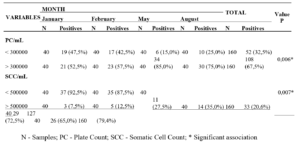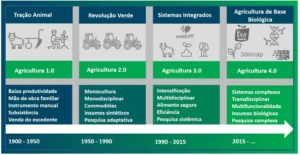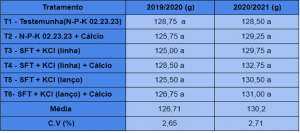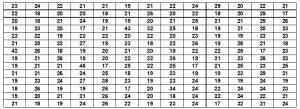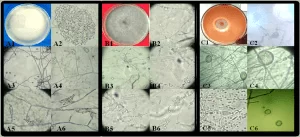ORIGINAL ARTICLE
ASSIS, Wesley Oliveira de [1], SANTOS, Dalmo de Freitas [2], TENÓRIO, Túlio Menezes [3], SOARES, Esly da Costa [4], BHATT, Rajan [5], OLIVEIRA, Mauro Wagner de [6]
ASSIS, Wesley Oliveira de. et al. Accumulation and allocation of dry matter and nutrients in brachiaria decumbens and ruziziensis in an intensive forage production system. Revista Científica Multidisciplinar Núcleo do Conhecimento. Year 08, Ed. 06, Vol. 02, pp. 159-178. June 2023. ISSN: 2448-0959, Access link: https://www.nucleodoconhecimento.com.br/agronomy-en/nutrients-in-brachiaria, DOI: 10.32749/nucleodoconhecimento.com.br/agronomy-en/nutrients-in-brachiaria
ABSTRACT
The objective of this study was to evaluate the accumulation and allocation of dry matter and nutrients by Brachiaria decumbens and ruziziensis, in three cuts, cultivated with an adequate supply of nutrients in the soil. The experimental design used was randomized blocks, with five replications, with plots consisting of five furrows of five meters in length, spaced 0.70 m apart. The average values of accumulation of Natural Matter (NM) and Dry Matter (DM) in the three cuts were, respectively, 41.0 and 6.53 t ha-1, every four weeks. There was no statistically significant difference (P≥0.05) between brachiaria; however, there was a significant effect (P≤0.05) of cutting time for forage production, since in the second cut the average production of the two brachiaria was 7.26 t of DM, surpassing in 11.77% the average of the first and third slices. In the average of the three cuts, the crude protein content of Brachiaria decumbens was 107.1 g kg-1, statistically higher than the crude protein content of Brachiaria ruziziensis (100.2 g kg-1). In the three cuts, high productivity of brachiaria decumbens and ruziziensis was observed in this intensive forage production system.
Keywords: Natural matter, Crude protein, Forage quality, Nutrient removal.
INTRODUCTION
Pastures are the main source of roughage for ruminants and, in recent years, there has been an increase in intensive forage production systems, especially those that improve the availability of nutrients for plants both by correcting soil acidity, and for supplying nutrients through chemical and organic fertilizers. In these more technified systems with higher productivity, it has been common to associate conservation management practices with practices to improve the physical, chemical and biological properties of the soil (Hennessy, et al., 2020; Oliveira et al., 2021a; Paciullo et al. , 2021b).
In order to increase the productivity of land and animals, several producers choose to replace the forage used with another forage, however, this practice may not maintain long-term improvement in results (Santos et al., 2021a). Thus, to effectively improve productivity, it is essential to reconstitute soil fertility through liming, plastering and chemical and organic fertilizers, in addition to loosening the surface layer of the soil, generated by intense animal trampling (Oliveira et al., 2021b, Santos et al., 2021a). In more fertile soils or soils that have been chemically and physically recovered, forage has higher levels of calcium, phosphorus and protein, and higher nutritional value, characterized by lower levels of cell wall constituents, which are cellulose, hemicellulose and lignin (Oliveira et al., 2017).
In sown or introduced pastures, there is a predominance of the genera Panicum and Urochloa (the latter previously designated Brachiaria). Livestock farmers have a preference for these plants due to their hardiness, their wide adaptation to different edaphoclimatic environments, associated with the high productive potential and good nutritional quality of the plants (Santos et al., 2021a). Santos et al. (2021a) in studies conducted with Brachiaria decumbens in an intensive production system, in Coruripe, eastern Alagoas state, report accumulation of dry matter in the aerial part of plants of 3.26 and 5.94 t per hectare, at 30 and 45 days after brachiaria emergence.
Due to this high production of dry matter, there is also a high removal of nutrients, and care must be taken to avoid impoverishment and acidification of the soil. Thus, one can adopt, as a fertilization criterion for more intensive systems, the replacement of nutrients removed as a result of grazing.
Thus, the objective of this study was to evaluate, in soil with an adequate supply of nutrients, the accumulation and allocation of dry matter and nutrients by Brachiaria decumbens (Urochloa decumbens) and Brachiaria ruziziensis (Urochloa ruziziensis), in three cuts, in the environment edaphoclimatic of Rio Largo – AL.
MATERIAL AND METHODS
STUDY PLACE
The study was conducted at the Campus of Engineering and Agricultural Sciences, at the Universidade Federal de Alagoas (CECA/UFAL) with geographic coordinates: altitude of 127 meters, latitude of 9° 28′ 49” South and longitude of 35° 51′ 29′ ‘ West, conducted between the months of April to September 2019 and rainfall volume totaled 963 mm according to data from the meteorological station located next to the study which another sector takes care of. According to the Köppen classification, the climate is humid coastal tropical (As), with an average annual temperature of 17.2 and 35.2 ºC. The soil used was classified as dystrophic Red-Yellow Latosol, with medium texture.
IMPLEMENTATION OF THE STUDY
Before the implementation of the study, soil samples were collected, with a known history of use, in layers from 0 to 20 cm and 20 to 40 cm. The soil had 64.96% base saturation in the 0 to 20 cm layer and no exchangeable aluminum in the 0 to 40 cm profile (Table 1). Thus, there was no need to apply acidity and gypsum correctives, following the recommendations of Cantarella et al. (2002), Barcelos et al. (2011) and Raj (2011). The choice of this soil aimed to provide a good supply of nutrients to the plants, without chemical impediment to the development of the root system of the plants, up to a layer of 40 cm (Raij, 2008; Oliveira et al., 2017).
The experimental design used was randomized blocks, with five replications, with plots consisting of five furrows five meters long and spaced 0.70 meters apart. At the bottom of the furrow opened for sowing, phosphorus was applied at a dose equivalent to 50 kg of P ha-1 (equivalent to 114.5 kg of P2O5) using simple superphosphate as a source of P, with the aim of increasing efficiency in the nitrogen metabolism and protein synthesis, since there is a strong interaction of N, P and S in biochemical routes (Oliveira et al., 2017). The phosphate fertilizer was covered with a layer of earth oscillating around 5 cm.
Nitrogen and potassium fertilizations were carried out in coverage, when the plants were about 5 cm high. Topdressing fertilizations were applied at doses equivalent to 150 kg of N and 150 kg of K per hectare, using ammonium sulfate and potassium chloride as nutrient sources. The use of ammonium sulfate aimed to eliminate N losses by volatilization (Oliveira et al., 2017) and increase the efficiency of N metabolism, as previously mentioned.
CUTTING AND COLLECTING THE BRACHIARIA
The seeds of Brachiaria decumbens (Urochloa decumbens cv. IPEAN) and Brachiaria ruziziensis (Urochloa ruziziensis cv. Kenedy), in amounts equivalent to 15 kg per hectare of pure viable seeds (SPV), were distributed manually in the furrows and covered with a thin layer of earth, around 1 cm. At 45 days after sowing, a cut of the plants was made at about 10 cm from the soil surface, to stimulate the tillering of the aerial part and increase the rooting of the plants (“leveling cut”). All the cut plant material was removed from the area and, again, the brachiaria were fertilized with ammonium sulfate and potassium chloride, in doses equivalent to 150 kg of N and K, per hectare.
At 29 days after the leveling cut, when there was approximately 90% of light interception by brachiaria (visual estimate), the first cut was performed to evaluate the accumulation and allocation of dry matter in the aerial part of brachiaria decumbens and ruziziensis. Sampling was carried out in the three central furrows of the plot, deducting one meter from each head of the plot. Again, the cut was made at about 10 cm from the soil surface and all the aerial biomass in the sample was weighed.
Plant subsamples were taken to quantify the partition of natural matter in the stems + petioles, and in the leaves. In the subsamples, the green leaves were separated from the rest of the plants, weighing each fraction again. These subsamples were dried in a forced ventilation oven at 50 °C until constant mass and weighed, following the procedures described by Malavolta et al. (1997) and Silva and Queiroz (2006). From these values, dry matter accumulations in stems + petioles and leaves were calculated. Dry matter accumulations in the aerial part of Brachiaria decumbens and Brachiaria ruziziensis were the sum of the dry matter of stems + petioles, and leaves, of the respective Brachiaria.
Subsamples of stems + petioles, and leaves were passed through a stainless steel mill and submitted to sulfuric and perchloric nitric digestion. The plant material was analyzed for N, P and K contents. Nitrogen contents were obtained by the Kjeldahl method, phosphorus by spectrocolorimetry and potassium by flame photometry, as described by Malavolta et al. (1997) and Silva and Queiroz (2006). The crude protein content was obtained by multiplying the nitrogen content by 6.25 (Silva and Queiroz, 2006). Accumulations of N, P, K and crude protein were obtained by multiplying the concentrations by the respective accumulations of dry matter in each plant fraction. By adding up the accumulations of N, P, K and crude protein in the stems + petioles, and in the leaves, the accumulation of these nutrients in the dry matter of the aerial part of Brachiaria decumbens and Brachiaria ruziziensis was obtained.
The day after cutting the plants, a new nitrogen and potassium fertilization was carried out, in doses equivalent to 150 kg of N and 150 kg of K, per hectare. At 27 days after the first cut, when there was approximately 90% of light interception, the second cut of the brachiaria was carried out, following the same procedures described for the first cut. After the second cutting of the plants, a new nitrogen and potassium fertilization was performed again, in doses equivalent to 150 kg of N and 150 kg of K, per hectare. At 29 days after the second cut, when there was approximately 90% of light interception, the third cut of the brachiaria was carried out, following the same procedures described for the first and second cuts.
STATISTICAL ANALYSIS
The results obtained were submitted to analysis of variance and, when there was a significant effect, the means were compared by the Scott-Knott test at 5%, using the SISVAR program (Ferreira, 2011).
RESULTS
ACCUMULATION AND ALLOCATION OF DRY MATTER IN THE AERIAL PART OF BRACHIARIA DECUMBENS AND RUZIZIENSIS
There was no significant effect (P≥0.05) of brachiaria species on natural matter (NM) and dry matter (DM) accumulation. However, there was significance for the cuts (P≤0.01) and for the allocation of dry matter in stems + petioles, and in leaves, with no interactive effect between these factors (P≥0.05) (Table 2).
In the three cuts, there was no difference between Brachiaria decumbens and Brachiaria ruziziensis regarding the daily accumulation of dry matter in the aerial part of the plants (Figure 1). The average values of dry matter accumulation rates throughout the aerial part of brachiaria in the first and third cuts were statistically equal, but lower than those of the second cut. For the first and third cuts, average rates of 221 and 203 kg of dry matter per hectare per day were observed. Taking as a reference (100%) the average dry matter accumulation rate of the first cut, the values of the second cut represent 121.50%. The higher rate of DM accumulation in the second cut was probably due to the greater water availability in the period and the beginning of the increase in the photoperiod.
Figure 2 shows the average values of dry matter accumulation in the stems + petioles, and in the leaves of Brachiaria decumbens and ruziziensis, as well as the allocation of dry matter in the first, second and third cuts. By analyzing Figure 2, it can be seen that in Brachiaria ruziziensis there was a greater allocation of dry matter to the leaves, while in Brachiaria decumbens the greater allocation of dry matter was to the stems + petioles. In the average of the three cuts, the percentage allocation of dry matter in the stems + petioles was 51%.
CRUDE PROTEIN CONCENTRATION IN DRY MATTER OF THE AERIAL PART OF BRACHIARIA DECUMBENS AND RUZIZIENSIS
There was a significant effect of brachiaria species, cut and plant part on crude protein levels (P≤0.01), with a coefficient of variation of 6.28% (Table 3). Analyzing Table 3, it can be seen that, in the average of the three cuts, the crude protein content in the entire aerial part of Brachiaria decumbens was 7.13% higher than the crude protein content in the entire aerial part of Brachiaria ruziziensis. In relation to the average crude protein contents in the entire shoot of brachiaria, in each cut, a significant effect was found for the third cut, which surpassed the other two cuts by about 10%. This increase in the concentration of crude protein in the third cut, both for Brachiaria decumbens and Brachiaria ruziziensis, can, in part, be explained by the lower accumulation of dry matter in the aerial part of the Brachiaria, in the third cut. The average accumulation of nitrogen throughout the shoot was statistically the same for the first and third cuts, with average values of 102 kg of N per hectare.
Regarding the average concentration of protein in the leaves or stems + petioles, it was found that Brachiaria decumbens had higher protein levels than Brachiaria ruziziensis. In the average of the three cuts, the crude protein content in Brachiaria decumbens leaves was 154.25 g kg-1, while for ruziziensis this concentration was 146.00 g kg-1, with a significant effect at 0.1% . The average protein concentration in stems + petioles in Brachiaria decumbens was 60.96 g kg-1, 11% higher than in Brachiaria ruziziensis: 54.75 g kg-1. Thus, it can be seen from Table 3 and Figure 3 that the protein contents of the entire aerial part of the brachiaria, in the three cuts, were of sufficient concentration for good fermentation and dry matter digestibility in the rumen.
REMOVAL AND BALANCE OF NUTRIENTS N, P AND K IN THE SOIL-PLANT SYSTEM
For phosphorus accumulation, there was a significant effect (P≤0.01) of brachiaria species and cut, with no interaction between these factors. For potassium, there was only a cut-off effect (P≤0.01) (Table 4). The coefficient of variation for P and K accumulation was 10.71 and 11.98%, respectively. In the average of the three cuts, phosphorus and potassium removals were 15.6 and 178 kg per hectare per cut. For nitrogen, according to values previously detailed in the item “Crude Protein”, the average removal was 107 kg per hectare per cut.
Based on the average nutrient removal values mentioned in the previous paragraph and also considering the average dry matter productivity of the three cuts, which was 6,530 kg per hectare (Table 2), we obtain N, P and K removal rates respectively of 16.38; 2.39 and 27.26 g per kg of dry matter. In the balance of nutrients in the soil-plant system, fertilization is considered as input and harvests as output. So, in the three cuts, 450 kg of N, 50 kg of P (114.5 kg of P2O5 equivalent) and 450 kg of K were applied. The average accumulated dry matter production in the three cuts was 19,590 kg per hectare, with a removal of 321 kg of N, 44.9 kg of P and 534 kg of K. It is then verified that the balance was positive for N, slightly positive for phosphorus and negative for potassium, which provided about 85% of the K removed by harvesting the aerial part of brachiaria.
DISCUSSION
ACCUMULATION AND ALLOCATION OF DRY MATTER IN THE AERIAL PART OF BRACHIARIA DECUMBENS AND RUZIZIENSIS
Under the edaphoclimatic conditions of the present study, a large accumulation of dry matter was observed in the aerial part of Brachiaria decumbens and ruziziensis, with an average of 6.53 t of dry matter per hectare every four weeks. High yields (t of dry matter per hectare) in plants of the brachiaria genus (Urochloa) are also reported in works conducted by Oliveira et al. (2021a) who reported dry matter accumulations of 10.0 t per hectare, 40 days after plant emergence.
In research carried out in a medium fertility soil, in the municipality of Cajuri – MG, Oliveira et al. (2022) also cite high dry matter production of brachiaria ruziziensis, cultivated after the harvest of first-crop corn, intended for silage. The rainfall from February to early June, sampling time for Brachiaria ruziziensis, was 282 mm, with March and April rainfall accounting for approximately 60% of the total. There was no application of fertilizers or pesticides on brachiaria cultivated after the corn harvest. Average accumulations of dry matter were observed in the aerial part of Brachiaria ruziziensis, which ranged from 12 to 14 t of dry matter per hectare. In this study, it was concluded that Brachiaria ruziziensis, cultivated after the harvest of first-crop corn, is an alternative for high forage production in dairy farms, compared to a new corn crop for silage (second-crop corn), especially in years with low precipitation from March onwards.
There is a widespread concept that brachiaria plants are capable of growing in soils with low levels of available P, and are therefore very efficient in using soil phosphorus, requiring no more than 20 kg of P per hectare, equivalent to 45 kg of P2O5 per hectare (Barcelos et al., 2011). However, this concept needs to be revised, especially in production systems that aim at high productivity and are implemented in soils with medium or low fertility (Oliveira et al., 2021a; Santos et al., 2021a; Oliveira et al., 2022).
In the third cut, possibly, the low rainfall that occurred in September (only 39 mm) associated with the high reference evaporation (118 mm), did not compensate for the increase in the photoperiod. In the study conducted by Sanches et al. (2017) to evaluate water consumption by four forage plants: Brachiaria brizantha cv. Marandu, Cynodon dactylon, Panicum maximun cv. Mombaça, for a period of 8 weeks, during the months of November, December and January, it was found that the average crop coefficients (Kc) of Marandu, Cynodon and Mombaça grasses were, respectively, 1.07, 0.99 and 1.09. So, based on the Kc obtained by Sanches et al. (2017), it can be assumed that moderate water deficiency occurred in the third cut. However, even in the first and third cuts DM accumulation rates were very high, with values above 200 kg per hectare per day.
In studies conducted in Coruripe, Alagoas, Santos et al. (2021a) evaluated dry matter accumulation by Brachiaria brizantha and Brachiaria decumbens in soil with 47% base saturation and phosphorus and potassium contents of 18 and 98 mg dm-3, respectively. The evaluations were carried out from 30 to 105 days after plant emergence (D.A.E.). During the entire study period, there was a high rate of dry matter accumulation, ranging from 74.5 to 135 kg of matter per hectare per day. The lowest mean accumulation value was verified in the sampling carried out at 90 D.A.E. (74.5 kg) and the largest at 45 DAE (135 kg), with a statistically significant effect at 0.1% between these mean values. For the other samplings (30, 60, 75 and 105 D.A.E) there was no effect on the average dry matter accumulation rate, which ranged from 88.5 to 103.3 kg of matter per hectare per day. At 90 and 105 D.A.E, dry matter accumulations in the aerial part of Brachiaria decumbens were, respectively, 14 and 16 t per hectare. One of the factors that may have contributed to the high rates of dry matter accumulation was the low acidity of the soils associated with the greater availability of nutrients (Oliveira et al., 2021a; Santos et al., 2021a).
Brachiaria ruziziensis had a greater allocation of DM to leaves, about 12% more than Brachiaria decumbens, consequently, Brachiaria ruziziensis had a lower percentage of DM allocated to stems + petioles. The association of these two factors, the percentage increase in DM allocated to leaves, with a corresponding percentage reduction in DM allocated to stems + petioles, should result in greater digestibility of Brachiaria ruziziensis, compared to Brachiaria decumbens, as discussed by Paciullo et al. (2021b).
The variation in the percentage of DM allocated to the leaves in relation to the allocation to the stems+petioles occurred mainly as a function of soil fertility or fertilization, especially nitrogen, with the influence of the phenological stage of the plants and the species of brachiaria. In the study by Portes et al. (2000), at 65 D.A.E., the total dry mass of the aerial part was approximately 4.5 t per hectare.
In an intensive forage production system, in Coruripe – AL, Santos et al. (2021a) report that in Brachiaria decumbens, at 30 D.A.E., 64.20% of the shoot DM was allocated to the leaves, but at 45 D.A.E this allocation was reduced to 48.32%, remaining practically unchanged at 60 D.A.E. However, for Brachiaria brizantha, a decrease in the percentage allocation of dry matter was observed with advancing plant age. At 30 D.A.E, the percentage allocation of dry matter in the leaves was similar to that of Brachiaria decumbens: 64.17%, but reduced to 50.60% at 45 D.A.E, being even lower at 60 D.A.E: 44.81%.
In the study carried out by Paciullo et al. (2021a), in a silvopastoral system, with low use of inputs, it was observed that, on average, 40% of the dry matter of the aerial part of Brachiaria decumbens was allocated in the leaves, but, in this study, the dry matter accumulation rate, even in summer it was less than 80 kg per hectare per day. In another study conducted by Paciullo et al. (2021b), however, with the brachiaria ruziziensis cultivar integra, also with low use of fertilizer, it can be seen that, in November, the average accumulation in the aerial part of the brachiaria was approximately 3.5 t per ha, and half was allocated to the leaves.
CRUDE PROTEIN CONCENTRATION IN DRY MATTER OF THE AERIAL PART OF BRACHIARIA DECUMBENS AND RUZIZIENSIS
The content or concentration of crude protein in forage plants is one of the most used variables in assessing the chemical quality of brachiaria (Francisco et al., 2017; Paciullo et al., 2021b; Oliveira et al., 2022). The availability of nutrients in the soil, especially nitrogen, phosphorus and sulfur, associated with climatic factors (light, temperature and humidity) have a great influence on forage protein levels (Oliveira et al. 2010; Oliveira et al., 2021a).
The increase in crude protein or nitrogen concentration, due to the decrease in dry matter accumulation, has been generically called the “dilution effect” (Raij, 2011; Oliveira et al., 2021b). Santos et al. (2021b) when evaluating the crude protein content of brachiaria decumbens and brizantha, 60 days after plant emergence, found that there was no effect of brachiaria species on the crude protein content of stems + petioles, with an average value obtained of 63.0 g per kg of dry matter or 6.3%. However, for crude protein content in leaves, there was a significant effect of species. The average crude protein content of the leaves of Brachiaria decumbens, 151 g kg-1, was about 10% higher than that of Brachiaria brizantha, resulting in a higher crude protein content of the aerial part of Brachiaria decumbens, compared to brizantha.
Lower levels of crude protein lead to a decrease in consumption and, consequently, maintenance requirements are not met, resulting in weight loss (Morais et al., 2013; Santos et al., 2021b). For this reason, the lower consumption and digestibility of tropical grasses at an advanced degree of maturity are related to the low levels of crude protein and, consequently, to the lower supply of ammonia in the rumen for cellulolytic bacteria (Kozloski, 2019; Oliveira et al., 2021b ).
REMOVAL AND BALANCE OF NUTRIENTS N, P AND K IN THE SOIL-PLANT SYSTEM
Brachiaria decumbens and ruziziensis had a high rate of matter accumulation in the adopted system, surpassing, in all cuts, 200 kg of dry matter per hectare per day. In intensive forage production systems, the adequate supply of nutrients to plants is a fundamental condition to maintain high productivity and the bromatological value of the biomass produced (Francisco et al., 2017; Oliveira et al., 2021b; Santos et al., 2021b). In these systems, the application of nitrogen fertilizers is essential, however, there may be an increase in aluminum in the soil solution due to acidification caused by ammonia and starch fertilizers (Raij, 2011; Oliveira et al., 2017). Thus, attention should also be paid to raising the exchangeable aluminum content, so that this element does not interfere negatively with the availability of nutrients in the soil, in the deepening of the root system and in the physiology of the plants (Raij, 2008; Oliveira et al. , 2021b).
In a study carried out by Raij and Quaggio (1984) it was evaluated in 24 soils whether exchangeable potassium would be the only form of the nutrient available for Brachiaria decumbens. Surface samples of six soils with latosol B horizon, nine with textural B horizon and one organic were used, as well as B horizon samples of seven soils with textural B and one Latosol. The test was carried out in vases with two liters of soil, obtaining three cuts of grass. The exchangeable potassium in the soil was analyzed at the beginning and at the end of the test and the potassium absorbed by the aerial part of the grass was determined. Potassium absorption in general exceeded the decrease in the amount of exchangeable potassium, between the beginning and the end of the experiment, by about 50% for the surface samples and more than twice for the B horizon samples, reaching ten times more in one case. Despite this, excluding a soil sample that had exceptional behavior, the absorbed potassium showed a high correlation with the exchangeable amount, both for the first cut (r = 0.911) and for the sum of the three cuts (r = 0.913). Based on these results, Raij and Quaggio (1984) concluded that Brachiaria decumbens used amounts of potassium that exceeded the exchangeable levels of soils, mainly from B horizon samples of podzolics.
High nutrient removals, in intensive production systems, or high productivity of brachiaria, are reported by Cantarella et al. (2002), Francisco et al. (2017), Oliveira et al. (2021a) and Santos et al. (2021b). It was confirmed with the results of the present study that, in intensive production systems, the restitution fertilization or the fertilization based on the productivity expectation is essential to maintain the high productivity and the bromatological value of the forage (Viana et al., 2011; Oliveira et al., 2021b; Oliveira et al., 2022).
CONCLUSIONS
In the edaphoclimatic conditions in which the present study was conducted, it can be seen that Brachiaria decumbens and ruziziensis had high productivity, since the average accumulation of dry matter (DM) in the three cuts was 6.53 t per hectare, every four weeks, thus resulting in DM accumulation of more than 200 kg per hectare per day.
REFERÊNCIAS
BARCELOS, L. J. A. et al. Adubação de capins do gênero Brachiaria. Empresa de Pesquisa Agropecuária de Minas Gerais – EPAMIG. Belo Horizonte, MG, 2011. Disponível em: <http://www.epamig.br/download/adubacao-de-capins-do-genero-brachiaria/>. Acesso em: 09 jan. 2023.
CANTARELLA, H. et al. Fertilidade do solo em sistemas intensivos de manejo de pastagens (p.99-131), In: PEIXOTO, A.M. et al. (eds). Inovações Tecnológicas no Manejo de Pastagens. Anais do 19°Simpósio sobre Manejo de Pastagens. Piracicaba: FEALQ, 231p., 2002. Disponível em: <file:///C:/Users/User%20-%20005/Downloads/Fertilidade_do_solo_em_sistemas_intensiv.pdf>. Acesso em: 13 jun. 2023.
FERREIRA, D. F. Sisvar: a computer statistical analysis system. Ciência e Agrotecnologia, Lavras, v. 35, n. 6, p. 1039–1042, 2011. Disponível em: <https://www.scielo.br/j/cagro/a/yjKLJXN9KysfmX6rvL93TSh/?lang=en>. Acesso em: 13 jun. 2023.
FRANCISCO, E. A. B.; SILVA, E. M. B.; TEIXEIRA, R. A. Aumento da produtividade de carne vai adubação de pastagens. Informações Agronômicas, 158, 6-12, 2017. Disponível em: <http://www.ipni.net/publication/ia-brasil.nsf/0/57237C870591958D83258153006D5BFF/$FILE/Page6-12-158.pdf>. Acesso em: 13 jun. 2023.
HENNESSY, D. et al. Increasing grazing in dairy cow milk production systems in Europe. Sustainability, 12, 2443, 2020. Disponível em: <file:///C:/Users/User%20-%20005/Downloads/sustainability-12-02443-v2.pdf>. Acesso em: 13 jun. 2023.
KOZLOSKI, G.V. Bioquímica dos ruminantes. Universidade Federal de Santa Maria. Santa Maria. 212 p. 3ª edição, 2ª reimpressão. 2019.
MALAVOLTA, E.; VITTI, G.C.; OLIVEIRA, S.A. Avaliação do estado nutricional das plantas: princípios e aplicações. Piracicaba: Associação Brasileira para Pesquisa da Potassa e do Fosfato, 1997. 211p.
MORAIS, M.G. et al. Consumo e digestibilidade de nutrientes em bovinos submetidos a diferentes níveis de ureia. Archivos de Zootecnia, 62, 239-246, 2013. Disponível em: < https://scielo.isciii.es/scielo.php?script=sci_abstract&pid=S0004-05922013000200009>. Acesso em: 13 jun. 2023.
OLIVEIRA, D. A. et al. Valor nutritivo do capim-braquiária no primeiro ano de recuperação com aplicações de nitrogênio e enxofre. Revista Brasileira de Zootecnia, 39, 716-726, 2010. Disponível em: <https://www.scielo.br/j/rbz/a/KsvMdW93GBpPtjFN5QbGcnM/abstract/?lang=pt>. Acesso em: 13 jun. 2023.
OLIVEIRA, M. W. et al. Mineral Nutrition and Fertilization of Sugarcane. In: (Ed.), Sugarcane: Technology and Research. IntechOpen, 2017. Disponível em: <https://doi.org/10.5772/intechopen.72300>. Acesso em: 13 jun. 2023.
OLIVEIRA, M.W. et al. Análise do crescimento da braquiária brizantha, usada como planta de cobertura do solo e recicladora de nutrientes. In: Congresso Internacional das Ciências Agrárias, Anais […], PDVAgro, 2021a.
OLIVEIRA, M.W. et al. Produção de cana-de-açúcar para a alimentação de bovinos. In: Alimentos e Alimentação Animal. Editora Científica Digital. Guarujá – SP. p. 81 a 117. 2021b. Disponível em: <https://downloads.editoracientifica.org/articles/210805744.pdf>. Acesso em: 13 jun. 2023.
OLIVEIRA, M.W. et al. Dry matter and protein accumulation as a function of nitrogen fertilization in brachiaria brizantha cv. marandu (Urochloa brizantha). Revista Brasileira de Agropecuária Sustentável (RBAS), 12, 1, 10-18, 2022. Disponível em: <https://periodicos.ufv.br/rbas/article/view/13125>. Acesso em: 13 jun. 2023.
PACIULLO, D. S. C. et al. Pasture and animal production in silvopastoral and open pasture systems managed with crossbred dairy heifers. Livestock Science, 245, 2021a. Disponível em: <https://www.sciencedirect.com/science/article/abs/pii/S1871141321000342>. Acesso em: 13 jun. 2023.
PACIULLO, D. S. C. et al. Produção de forragem de Brachiaria ruziziensis cv. BRS Integra sob pastejo, ao longo do ano. Boletim de Pesquisa e Desenvolvimento, n.43. EMBRAPA- CNPGL. 2021b. 23 p.
PORTES, T. A. et al. Análise do crescimento de uma cultivar de braquiária em cultivo solteiro e consorciado com cereais. Pesquisa Agropecuária Brasileira, 35, 1349-1358, 2000. Disponível em: <https://www.scielo.br/j/pab/a/fKBPgXqjR3rtL8SjxNRcR8w/?format=pdf&lang=pt>. Acesso em: 13 jun. 2023.
RAIJ, B. Gesso na agricultura. Campinas: Instituto Agronômico de Campinas, 2008. 233p.
RAIJ, B. Fertilidade do solo e manejo de nutrientes. Piracicaba: International Plant Nutrition Institute, 2011. 420p.
RAIJ, B.; QUAGGIO, J. A. Disponibilidade de potássio em solos para capim-braquiária cultivado em vasos. Bragantia, 3, 531- 539, 1984. Disponível em: <https://www.scielo.br/j/brag/a/vMM8TJDBBRvKfTddTj34Tcv/?lang=pt>. Acesso em: 13 jun. 2023.
SANCHES, A. C. et al. Consumo de água de forrageiras tropicais no período de formação de pastagem. Revista Brasileira de Agricultura Irrigada. 11, 1291-1301, 2017. Disponível em: < https://repositorio.usp.br/item/002848362>. Acesso em: 13 jun. 2023.
SANTOS, D. F. et al. Acúmulo e partição da matéria seca nas braquiárias brizantha e decumbens, na região de Coruripe, AL. In: Congresso Internacional da Agroindústria (CIAGRO), Anais […], 2021a. Disponível em: <https://ciagro.institutoidv.org/ciagro2021/uploads/107.pdf>. Acesso em: 13 jun. 2023.
SANTOS, D. F. et al. Proteína bruta e macronutrientes nas folhas e caules das braquiárias brizantha e decumbens aos 60 dias pós emergência. In: VI Congresso Internacional das Ciências Agrárias (COINTER), Anais […], 2021b. Disponível em: <https://cointer.institutoidv.org/smart/2021/pdvagro/uploads/566.pdf>. Acesso em: 13 jun. 2023.
SILVA, D. J., QUEIROZ, A. C. Análise de alimentos: métodos químicos e biológicos. 3ª ed. Viçosa: UFV. 2006. 235 p.
VIANA, M. C. M. et al. Adubação nitrogenada na produção e composição química do capimbraquiária sob pastejo rotacionado. Revista Brasileira de Zootecnia, 40, 1497-1503, 2011. Disponível em: <https://www.scielo.br/j/rbz/a/Q3yNqWqbkqzCN3cdMSnnVBK/?lang=pt>. Acesso em: 13 jun. 2023.
ATTACHMENT
Tabela 1. Resultados analíticos da amostra de solo em diferentes camadas da área do estudo
| Layer | pH in | P | K | Ca | Mg | Al+3 | H+Al | SB | CTC (t) | CTC (T) | V | m | |
| H2O | mg dm-3 | Cmolc dm-3 | % | ||||||||||
| 0 a 20 cm | 6.0 | 35 | 57 | 3.45 | 0.65 | 0.00 | 2.29 | 4.25 | 4.25 | 6.54 | 64.96 | 0.00 | |
| 20 a 40 cm | 5.6 | 18 | 23 | 2.38 | 0.42 | 0.00 | 2.04 | 2.86 | 2.86 | 4.90 | 58.36 | 0.00 | |
Source: author, 2023.
Table 2. Mean squares of the analysis of variance and coefficient of variation (C.V.) for the accumulation of natural matter in the entire shoot (Ac. NM P.A.), accumulation of dry matter in the entire shoot (Ac. DM P.A.), accumulation of dry matter in leaves (Ac. DM Fl), accumulation of dry matter in stems + petioles (Ac. DM C+P), in brachiaria decumbens and ruziziensis, in a study conducted in Rio Largo – AL
| Source of Variation |
GL |
——————————- Mean squares ———————————- | |||
| Ac. NM P.A. | Ac. DM P.A. | Ac. DM C+P | Ac. DM Fl | ||
| Brachiaria (B) | 1 | 33.325, 4ns | 81.077,3 ns | 50,4* | 990,5* |
| Cut (C) | 2 | 165.668,4*** | 4.639,5*** | 102,8* | 1.365,6*** |
| Block | 4 | 8.901,4 | 529,6 | 8,5 | 299,7 |
| B x C | 2 | 28.096,4 ns | 487,7 ns | 7,3 ns | 197,2 ns |
| Residue | 20 | 17.539,9 | 588,6 | 21,9 | 158,7 |
| General Average (t ha-1) | 41,43 | 6,53 | 3,33 | 3,20 | |
| C.V. (%) | 10,11 | 11,75 | 14,08 | 12,44 | |
***, **, *significant, respectively at 0.1%, 1.0 and 5% of probability by the F test. Source: author, 2023.
Figure 1. Average rates of daily dry matter accumulation in the entire aerial part of Brachiaria decumbens and ruziziensis, in the three cuts
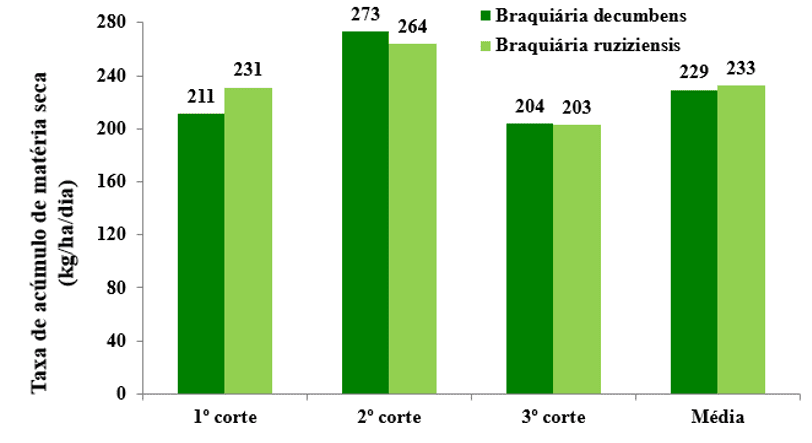
Figure 2. Mean values of dry matter accumulation in stems + petioles and leaves of Brachiaria decumbens and ruziziensis in the first, second and third cuts
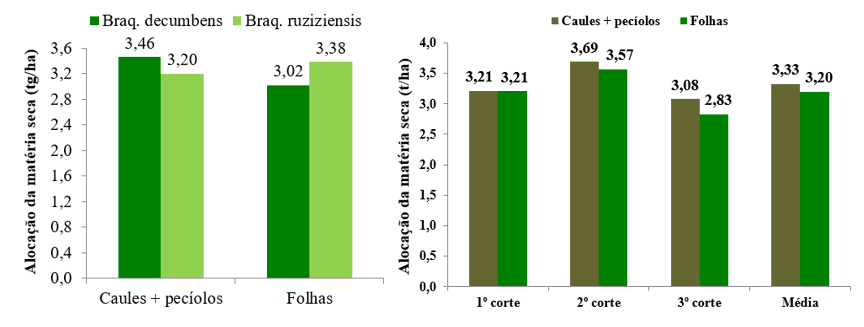
Table 3. Average levels of crude protein in the entire aerial part of Brachiaria decumbens and ruziziensis, in the study conducted in Rio Largo – AL
| Cut (g kg-1) | Brachiaria decumbens | Brachiaria ruziziensis | Average |
| 1º | 105,50 b A | 94,67 a A | 100,08 A |
| 2º | 102,85 a A | 98,73 a A | 100,77 A |
| 3º | 113,04 b B | 107,27 a B | 110,15 B |
| Average | 1007,13 b | 100,22 a | 103,67 |
Means followed by the same lowercase letter in the row or uppercase in the column do not differ by the Scott-Knott test at 5% probability. Source: author, 2023.
Figure 3. Mean values of crude protein concentrations in the entire aerial part of Brachiaria decumbens and ruziziensis, in the first, second and third cuts, compared to the minimum concentration for a good rumen fermentation condition
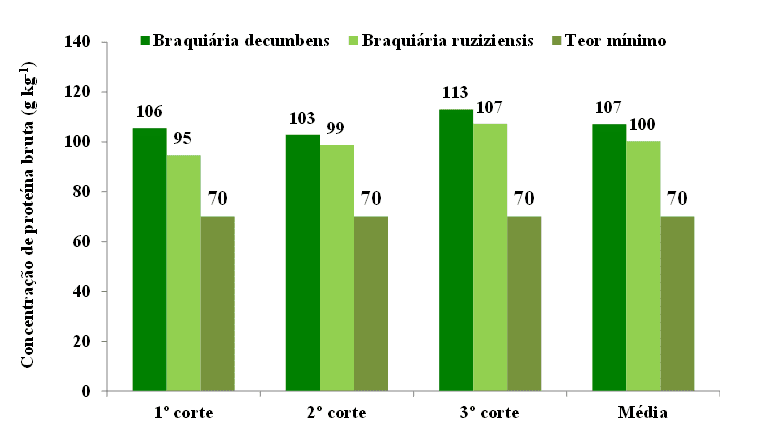
Means followed by the same lowercase letter in the row or uppercase in the column do not differ by the Scott-Knott test at 5% probability
| Cut | Phosphorus Accumulation (kg ha-1) | Potassium accumulation (kg há-1) | ||||
| Brac. dec. | Brac. ruz. | Average | Brac. dec. | Brac. ruz. | Average | |
| 1º | 14,4 aB | 18,7 bB | 16,5 B | 160 aA | 188 aA | 174 A |
| 2º | 15,0 aB | 18,6 bB | 16,8 B | 196 aB | 194 aA | 195 B |
| 3º | 12,7 aA | 14,4 aA | 13,5 A | 159 aA | 169 aA | 164 A |
| Average | 14,0a | 17,2b | 15,6 | 172a | 184a | 178 |
Source: author, 2023.
[1] PhD candidate in agronomy (plant production), master in agronomy (plant production), graduated in agronomy and technician in agriculture. ORCID: 0000-0002-3172-180X. Curriculum Lattes: http://lattes.cnpq.br/1670117803159788.
[2] Master’s student in agronomy (vegetable production), graduated in agronomy. ORCID: 0000-0002-9446-5612. Curriculum Lattes: http://lattes.cnpq.br/7048085400947895.
[3] Master’s student in agronomy (vegetable production), graduated in agronomy. ORCID: 0000-0003-2394-0719. Curriculum Lattes: http://lattes.cnpq.br/6783388366447522.
[4] Graduated in Animal Science. ORCID: 0000-0003-4443-6175. Curriculum Lattes: http://lattes.cnpq.br/0159149164304281.
[5] Professor of Soil Sciences. ORCID: 0000-0001-9977-9955.
[6] Advisor. PhD in Agronomy (Plant Production), Master in Agronomy (Plant Production), Graduated in Agronomy and Agricultural Technician. ORCID: 0000-0002-3837-429X. Curriculum Lattes: http://lattes.cnpq.br/3734599827816945.
Submitted: May 18, 2023.
Approved: June 13, 2023.

